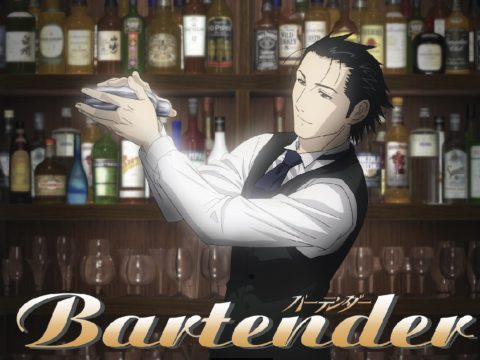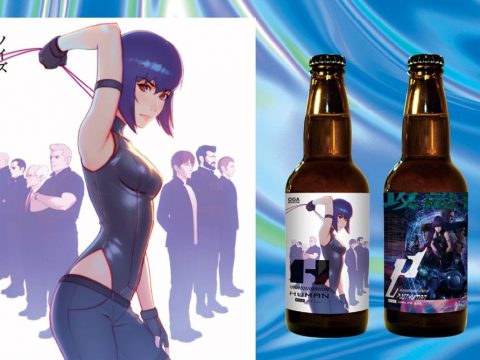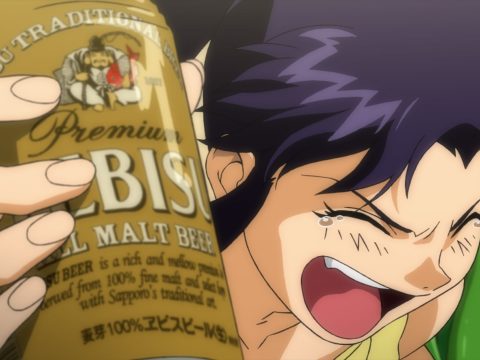[Excerpted from the October 2007 issue of Otaku USA Magazine]
It is Friday night in Kansai (the eastern side of Japan) and whether you are a furita or a salaryman there is only one thing on your mind -a good place to have a drink. Pass by every major train station in the country and you will find a number of beer gardens, oden stands, and izakaya serving beverages for the masses looking to unwind after a hard work week. Libations, like manga, play a major role in the social and cultural fabric in Japan. And, like manga, alcohol is something practically every adult partakes in, as it’s relatively affordable, highly accessible, and mood altering.
A developing trend has taken drinking culture from the pub to the mass media. Alcohol appreciation has to an extent hit the mainstream. You possibly know of the vending machines that sell mini-kegs of beer and liter bottles of shochu, but alcohol has Japanese media tipsy with glee. Radio stations are devoting programming to cocktail making and wine tasting. Variety show hosts are spending more and more time in bars and less time in the studio. And manga has succumbed to peer pressure in a big way.
Adult beverages are increasingly becoming an integral part of every mature manga magazine’s catalog. Flip through the salarymanic pages of seinen manga magazines like Futabasha’s Manga Action or Kodansha’s Evening and the drinking manga enthusiast can find a handful of titles to  choose from this suddenly popular genre. Josei mags like Kodansha’s KISS and Shueisha’s You Magazine turn bars into settings for tragedy and triumph and the hostesses who work in these establishments are heroines women admire. Alcohol has permeated the depths of Japanese manga and it is becoming more refined and specific than ever.
choose from this suddenly popular genre. Josei mags like Kodansha’s KISS and Shueisha’s You Magazine turn bars into settings for tragedy and triumph and the hostesses who work in these establishments are heroines women admire. Alcohol has permeated the depths of Japanese manga and it is becoming more refined and specific than ever.
Back in the 80s, bars in manga were generally frequented by the bad boys of comics. Lupin III and Jigen might plan a heist over some gin and tonic. The wine-swilling Captain Harlock and Tochiro often had whiskey on the rocks in an intergalactic saloon before taking on a soulless enemy. To see regular folks go to a bar was not rare either. Salarymen and OL have always had their place in bars and izakaya; however, the bar itself was rarely at the core of these stories.
Furuya Mitsuhito’s BAR Lemon Heart changed that by making the bar the main character of his manga. Since its debut in Futubasha’s Manga Action magazine in 1986, this manga has consistently served up comical cocktails of equal parts alcohol culture and drinking man’s romance. To any character in this series, entering Lemon Heart has been analogous to drinking at Japan’s ideal bar. First impressions would lead one to believe Lemon Heart would be a dive, as it is tucked inside the first floor of a broken-down building in Tokyo’s Minato warehouse district. Enter its doors and visitors are welcomed by a quaint establishment with a very casual motif. Dim lighting, expensive bottles of top-shelf booze behind the bar, and a nameless barkeep known only as”Master” await s and booze hounds alike. Master generally keeps conversation to a minimum as the regulars solely focus on their drinks. And the only time silence ever appears to be broken is when a glass needs to be refilled or when Master and his alcohol-loving guests share wisdom about the alcohol being served. Occasionally, Furuya reminds his readers that there is a great world outside of his BAR Lemon Heart, yet his characters and his readers should not really care.

Drinking does not get cooler than BAR Lemon Heart, but it does get even more detailed. Every chapter of Lemon Heart has its own theme; one chapter might be German beers, the next might be Okinawan shochu. Through the Master, guests and in turn readers learn general information about the drinks being served. Like the art in that title, the info is not very detailed, leaving the legwork to the reader. Manga writer Joe Araki has made a living writing about bar culture since the mid-90s. In practically every one of his titles, Joe completely ignores the concept of narrative to spotlight a particular drink. Now that might not be unique at all, if not for the detail in which he examines each.
When reading a title like Joe’s La Sommeliere, readers are treated to a series with high information content. Those who have not built up a tolerance for such dense reading may find the lack of narrative frustrating. However, to the hardcore manga gourmand this is a casual learning tool. Each chapter provides information ranging from popular vintages to appropriate food pairings, and a little history on the classifications of each wine. At the end of each book, Joe provides essays about wine culture and even has included cheat sheets readers can cut out for use when they next go wine shopping. Joe’s bias for California wines has been mentioned on US websites, but this latest title in his sommelier trilogy does a fine job introducing wine from Europe as well as small Japanese vineyards
 It’s not surprising that drinking manga has opened the door for some women to start reading more seinen over the last few years. More and more women are going to drinking establishments, and businesses specifically targeting females are also on the rise. It is easy to see why women make up a nice following for these manga titles. Wine manga in particular is quite popular with female readers, as these titles are often used as a primer for people to get into casual oenology.
It’s not surprising that drinking manga has opened the door for some women to start reading more seinen over the last few years. More and more women are going to drinking establishments, and businesses specifically targeting females are also on the rise. It is easy to see why women make up a nice following for these manga titles. Wine manga in particular is quite popular with female readers, as these titles are often used as a primer for people to get into casual oenology.
Generally, drinking manga specially targeted to josei revolve around the bar staff instead of the alcohol being consumed. In Yamada Keiko’s Kyaba Mama (“Cabaret Bar Mama”), lead character and single mom Asahina Himawari raises her 8-year-old son and at night she offers nomihodai drinks (bottomless drinks) while providing clients company at her hostess bar. The pressures of raising a kid are nothing compared to the late-night rigors of a service industry entirely based on looks and personality. The male hosts of Shindo Fuyuki’s seinen manga Night Knight Story also know that their looks are priority one and they are loved by the ladies for that very reason. The high-rolling women of the Kanto (Tokyo) region and the tasty young men of Club Pony are the perfect pairing for a bottle of champagne or a whiskey on the rocks. These titles have a competitive feel to them. Hosts and hostesses not only struggle to balance their personal lives with their business lives, but they often battle each other, rival bars, and at times their costumers for business! Competition is tough in the world of “water business” (a euphemism for adult entertainment) and apparently that makes good drama.
While manga alone might not quench the thirst of mature manga readers, these books provide cheap thrills and good conversation starters. As the summer heats up the number of readers looking for information on the world of adult beverages will have plenty of places to turn. And the Japanese are not alone when enjoying this phenomenon, either. Korea’s recent multimillion dollar wine boom was influenced by Kodansha’s best-selling Le Gouttes de Dieu. And let’s not forget how Ouran High School Host Club has introduced young women in North America to Japan’s mizu shobai (“water business” culture! So next time you feel a thirst for manga infotainment consider toasting with a title like BAR Lemon Heart – amusing, informative, and full of spirits.
Read more of Ed Chavez’s manga news and reviews at the MangaCast website.






![Takunomi. [Review] Takunomi. [Review]](https://otakuusamagazine.com/wp-content/uploads/2018/06/Takunomi-01-Large-09-480x360.jpg)